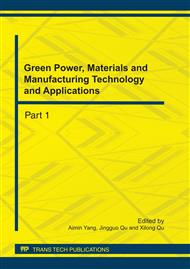p.607
p.613
p.618
p.622
p.626
p.631
p.635
p.641
p.646
Enhanced Electrokinetic Removal of Heavy Metals in MSWI Fly Ash Assisted by Cation Exchange Membranes
Abstract:
Since MSWI fly ash enriches heavy metals and many toxic components and these components would potentially leach when the ashes are land filled, it is regulated as hazardous waste in many countries. Electrokinetic removal, an electrochemically assisted extraction method, has recently been adopted as a new method for removal of heavy metals from MSWI fly ashes. But the generation of metal hydroxide precipitation near the cathode decreased conductivity of electrokinetic removal system and limited metal extraction from the sample area. In this study, cation exchange membrane was used in electrokinetic removal experiment to improve this method. After 192 hours of electrokinetic removal, about 15%Cd,20%Pb, 30% Zn, and 10% As was removed from 2.850kg MSWI fly ash. It showed positive effect compared to the trial test. But there still exists some problems, such as low removal efficiency. Further work should be done to solve it.Moreover, the high conductivity in fly ash limits the current , which in turn causes low electroosmotic flow. While electroosmotic flow is the main factor leting the heavy meatals release from fly ash, it would become the focus in further experiment to look for ways increasing the electroosmotic flow in sample cell.
Info:
Periodical:
Pages:
626-630
Citation:
Online since:
August 2011
Authors:
Price:
Сopyright:
© 2011 Trans Tech Publications Ltd. All Rights Reserved
Share:
Citation:


